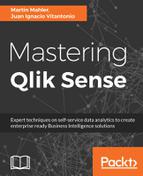Utilizing this feature can be very powerful in the following three use cases:
- Maintaining business logic: Master Items can help with preserving business logic within an app. By being able to organize and govern aggregation logic for metrics as well as essential dimensions centrally, the dashboard owner can ensure that all sheets and visualizations are using the same expressions and efficiently aggregating data correctly and consistently across the app. The same applies to critical dimensions. Very often, data models will have a collection of various fields, but not all of them will be relevant or meaningful in the context of metrics.
- Code maintenance: It is not uncommon for apps to evolve. More complex aggregations are introduced to answer the surge of questions the business has, and the data model itself grows - not only in rows, but also in columns. New dimensions or tables might be added to enrich the existing data set. The challenge with every evolving app is to maintain the code, predominantly for expressions. By using Master Items, you can ensure that everything is kept in one place, and that updating, if required, can be easily changed on that one place and see the change affect the whole app. The best example is the renaming of existing dimension fields to something more meaningful to avoid ambiguity. If the app has already reached an evolved stage, using Master Items, that name change only needs to occur in one place. There is an additional level of expression governance recommended, using variables, which is described in the expression chapter in Module 2. The same also goes for visualizations that are reused in multiple places across the app – deploying them as Master Items allows changes to propagate across each copy.
- Governance for self-service: Coming back to the self-service model and its conflict with governance described in Chapter 1, Qlik Sense Self-Service Model, Master Items can be a great way, if not the best way, to put governance on an app in place, while at the same time keeping the freedom of self-service. By building an app-specific rich framework of permissible measures, dimensions, and especially visualizations, the user can create his bespoke reports and visualizations without risking breaking the app or presenting wrong numbers.
It ensures that aggregation logic in metrics is consistent across the app, and most relevant dimensions are also consistently used in each visualization. Using a simple drag and drop mechanism, building dashboards using the primary metrics of a data model becomes a very comprehensive exercise for the business users and prevents overwhelming them with a complicated data model structure that needs to be understood and considered. At the same time, if users are only allowed to utilize the Master Items, they will not be able to write free expressions or create a Cartesian combination of several dimensions, resulting in a possible blowout of the RAM of the Qlik Sense server.
